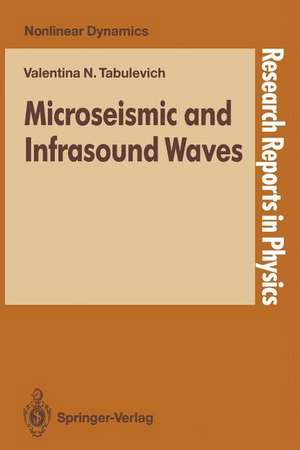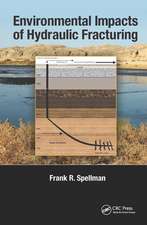Microseismic and Infrasound Waves: Research Reports in Physics
Autor Valentina N. Tabulevichen Limba Engleză Paperback – 6 aug 1992
Din seria Research Reports in Physics
- 15%
 Preț: 643.48 lei
Preț: 643.48 lei - 15%
 Preț: 650.37 lei
Preț: 650.37 lei - 15%
 Preț: 642.18 lei
Preț: 642.18 lei - 15%
 Preț: 646.30 lei
Preț: 646.30 lei - 15%
 Preț: 645.14 lei
Preț: 645.14 lei - 15%
 Preț: 634.68 lei
Preț: 634.68 lei - 15%
 Preț: 638.43 lei
Preț: 638.43 lei - 15%
 Preț: 638.76 lei
Preț: 638.76 lei - 15%
 Preț: 642.36 lei
Preț: 642.36 lei - 15%
 Preț: 640.06 lei
Preț: 640.06 lei - 15%
 Preț: 636.80 lei
Preț: 636.80 lei - 15%
 Preț: 640.24 lei
Preț: 640.24 lei - 15%
 Preț: 640.37 lei
Preț: 640.37 lei - 15%
 Preț: 642.83 lei
Preț: 642.83 lei - 15%
 Preț: 633.35 lei
Preț: 633.35 lei - 15%
 Preț: 634.68 lei
Preț: 634.68 lei - 15%
 Preț: 632.70 lei
Preț: 632.70 lei - 15%
 Preț: 646.62 lei
Preț: 646.62 lei - 15%
 Preț: 635.96 lei
Preț: 635.96 lei -
 Preț: 380.07 lei
Preț: 380.07 lei -
 Preț: 385.84 lei
Preț: 385.84 lei -
 Preț: 539.31 lei
Preț: 539.31 lei - 15%
 Preț: 636.80 lei
Preț: 636.80 lei -
 Preț: 388.90 lei
Preț: 388.90 lei - 15%
 Preț: 632.22 lei
Preț: 632.22 lei
Preț: 634.00 lei
Preț vechi: 745.88 lei
-15% Nou
Puncte Express: 951
Preț estimativ în valută:
121.32€ • 127.25$ • 100.99£
121.32€ • 127.25$ • 100.99£
Carte tipărită la comandă
Livrare economică 01-15 aprilie
Preluare comenzi: 021 569.72.76
Specificații
ISBN-13: 9783540532934
ISBN-10: 3540532935
Pagini: 164
Ilustrații: IX, 150 p. 8 illus.
Dimensiuni: 155 x 235 x 9 mm
Greutate: 0.24 kg
Ediția:Softcover reprint of the original 1st ed. 1992
Editura: Springer Berlin, Heidelberg
Colecția Springer
Seria Research Reports in Physics
Locul publicării:Berlin, Heidelberg, Germany
ISBN-10: 3540532935
Pagini: 164
Ilustrații: IX, 150 p. 8 illus.
Dimensiuni: 155 x 235 x 9 mm
Greutate: 0.24 kg
Ediția:Softcover reprint of the original 1st ed. 1992
Editura: Springer Berlin, Heidelberg
Colecția Springer
Seria Research Reports in Physics
Locul publicării:Berlin, Heidelberg, Germany
Public țintă
ResearchCuprins
1. Excitation of Microseisms and Infrasound Vibrations.- 1.1 Formation of Microseisms from Sea Waves.- 1.2 SMS Excitation.- 1.3 Comparison of Existing Theories of SMS Excitation.- 1.4 Theories of SMS and Infrasound Generation by Standing Sea Waves.- 1.5 Hasselman Theory.- 1.6 Nanda Theory of SMS Generation.- 1.7 Primary and Secondary Shore Microseisms.- 2. Sources of Excitation of SMS and IS.- 2.1 Observations on the Caspian Sea. Establishment of Fundamental Relations.- 2.2 Observations of SMS on Lake Baikal.- 2.3 Microseismic Storms on the Okhotsky Sea.- 2.4 Observations of Hydrometeorological Conditions and SMS on Oceans. Recording of Alternating Pressures on the Ocean Bottom.- 2.5 Recording Infrasound Vibrations in the Atmosphere and Microseisms.- 2.6 Observations on SMS in the Shore Zone and on the Ocean Bottom.- 2.7 Experimental Confirmation of the Theory of Standing Waves, MS and Infrasound.- 3. Decomposition of MS Noise into Discrete Sources of MS Excitation.- 3.1 Separation of MS Noise According to Frequency Synchronism.- 3.2 SMS Spectra.- 3.3 Separation of Seismic “Noise” into Components Arriving from Different Sources.- 4. Determination of Power, Energy and Positions of Sources of MS Excitation.- 4.1 Source Position.- 4.2 Source Power and Energy.- 4.3 Determination of Position and Power of MS Sources Using the Power Constant.- 4.4 Shape and Size of MS Sources.- 5. MS as an Indicator of Storm Phenomena, Water Wave Regimes, Infrasound Waves and Geometric Excitations.- 5.1 Phenomena Which Arise with SMS.- 5.2 Formation of Standing Sea Waves and SMS.- 5.3 Influence of the Velocity of a Cyclone Center on MS Formation.- 5.4 Directionality of SMS and IS Radiation by an Array of Standing Sea Waves.- 5.5 Velocity of a Cyclone Center, SMS and Magnetic Storms.- 5.6Perturbations in the Ionosphere and Fluctuations of the Geomagnetic Field.- 5.7 Geomagnetic Storms, Telluric Currents, Geomagnetic Micropulsations and SMS.- 5.8 Variations of Global MS Vibrations.- 5.9 Propagation of Radiowaves and MS Storms on Oceans.- 6. MS Vibrations in Engineering Seismology.- 6.1 Use of MS in Estimating the Seismic Response of Soils. Electrodynamic Analogy.- 6.2 High Frequency MS.- 6.2.1 Spontaneous MS.- 6.2.2 Mechanical Vibrators.- 6.3 Low Frequency MS.- 6.4 Further Possible Applications of MS.- References.













